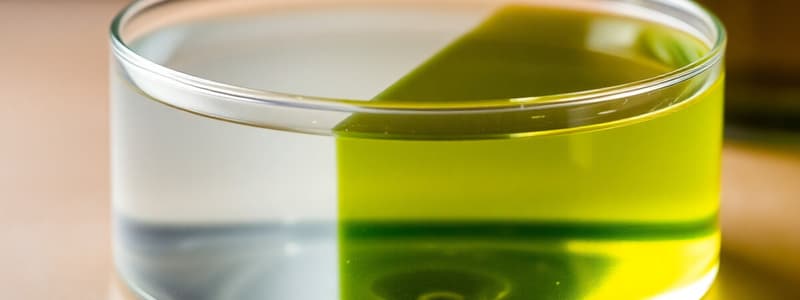Podcast
Questions and Answers
What is the acceptable range for the absolute value of the coefficient (a) in scientific notation?
What is the acceptable range for the absolute value of the coefficient (a) in scientific notation?
- 0 < a < 1
- 0 ≤ a < 10
- 10 ≤ a < 100
- 1 ≤ a < 10 (correct)
What is the term used for the number that occurs before the 10ⁿ part in scientific notation?
What is the term used for the number that occurs before the 10ⁿ part in scientific notation?
- Mantissa (correct)
- Exponent
- Significant Figure
- Coefficient
Which of the following examples represents the number 24327 in scientific notation?
Which of the following examples represents the number 24327 in scientific notation?
- 2.4327 x 10³
- 2.4327 x 10¹⁴
- 2.4327 x 10⁵
- 2.4327 x 10⁴ (correct)
In the formula for calculating relative atomic mass, what does the symbol Σ represent?
In the formula for calculating relative atomic mass, what does the symbol Σ represent?
Which of the following is a valid characteristic of the coefficient (a) in scientific notation?
Which of the following is a valid characteristic of the coefficient (a) in scientific notation?
What process describes the change from solid to liquid?
What process describes the change from solid to liquid?
Which method involves the separation of particles based on centrifugal force?
Which method involves the separation of particles based on centrifugal force?
What is the correct term for the process in which a gas turns into a solid?
What is the correct term for the process in which a gas turns into a solid?
Which separation technique is based on the different boiling points of components?
Which separation technique is based on the different boiling points of components?
Which of the following best defines a physical property?
Which of the following best defines a physical property?
What process is used to separate a mixture by passing it through a medium at different rates?
What process is used to separate a mixture by passing it through a medium at different rates?
In which process does a solid directly change into a gas?
In which process does a solid directly change into a gas?
Which term refers to the chemical breakdown produced by an electric current?
Which term refers to the chemical breakdown produced by an electric current?
What is the correct conversion for 1 meter in inches?
What is the correct conversion for 1 meter in inches?
If you add 3.456 and 2.3, what should the final answer be in terms of significant figures?
If you add 3.456 and 2.3, what should the final answer be in terms of significant figures?
Which unit is equivalent to a milli?
Which unit is equivalent to a milli?
What is the maximum number of significant figures that can be in the answer when adding the numbers 4.56 and 3.2?
What is the maximum number of significant figures that can be in the answer when adding the numbers 4.56 and 3.2?
How many grams are in 1 pound?
How many grams are in 1 pound?
What is the equivalent amount of 1 liter in quarts?
What is the equivalent amount of 1 liter in quarts?
When performing multiplication, how do you determine the number of significant figures in your final answer?
When performing multiplication, how do you determine the number of significant figures in your final answer?
How many centimeters are there in 1 inch?
How many centimeters are there in 1 inch?
What is the first step in determining the empirical formula from a compound's composition?
What is the first step in determining the empirical formula from a compound's composition?
How is the empirical formula determined after finding the moles of each element?
How is the empirical formula determined after finding the moles of each element?
What is the next step after obtaining the empirical formula?
What is the next step after obtaining the empirical formula?
If an empirical formula C₆H₈O₃ has a molecular mass of 128.127 g/mol, how would you find the ratio of the molecular mass of a compound with a molar mass of 256.26 g/mol?
If an empirical formula C₆H₈O₃ has a molecular mass of 128.127 g/mol, how would you find the ratio of the molecular mass of a compound with a molar mass of 256.26 g/mol?
What is the final empirical formula produced when the ratio is found to be 2 for the compound C₆H₈O₃?
What is the final empirical formula produced when the ratio is found to be 2 for the compound C₆H₈O₃?
What is the empirical formula for a compound with 52.14% C, 13.13% H, and 34.73% O?
What is the empirical formula for a compound with 52.14% C, 13.13% H, and 34.73% O?
How do you calculate the percent by mass of an element in a compound?
How do you calculate the percent by mass of an element in a compound?
What is the formula to find the molar mass of a compound such as FeCl3?
What is the formula to find the molar mass of a compound such as FeCl3?
What percentage by mass of hydrogen is present in water (H2O)?
What percentage by mass of hydrogen is present in water (H2O)?
Which statement best describes the molecular formula?
Which statement best describes the molecular formula?
If a compound contains 34.43% by mass of Iron, what is the mass of Iron in 100 g of the compound?
If a compound contains 34.43% by mass of Iron, what is the mass of Iron in 100 g of the compound?
How do you find the mole ratio from the calculated moles of each element?
How do you find the mole ratio from the calculated moles of each element?
Which of the following compounds has a molecular mass of approximately 18.02 g/mol?
Which of the following compounds has a molecular mass of approximately 18.02 g/mol?
To find the subscript in an empirical formula when you have decimal mole ratios, what method would you use?
To find the subscript in an empirical formula when you have decimal mole ratios, what method would you use?
What is the total molar mass of FeCl3?
What is the total molar mass of FeCl3?
Calculating the percent composition of an element requires which of the following?
Calculating the percent composition of an element requires which of the following?
When given a percent composition, the first step in finding the empirical formula is to assume how many grams of the compound?
When given a percent composition, the first step in finding the empirical formula is to assume how many grams of the compound?
If the mole ratio for an empirical formula calculation results in 1.999 H, what should it be rounded to?
If the mole ratio for an empirical formula calculation results in 1.999 H, what should it be rounded to?
The molar mass of which of the following elements is closest to the mass of hydrogen?
The molar mass of which of the following elements is closest to the mass of hydrogen?
Flashcards are hidden until you start studying
Study Notes
Phase Changes
- Melting: Transition from solid to liquid.
- Boiling/Evaporation: Transition from liquid to gas.
- Condensation: Transition from gas to liquid.
- Sublimation: Transition from solid to gas.
- Deposition: Transition from gas to solid.
Separation Techniques
- Magnetic/Mechanical Separation: Utilizes tools like forceps, sieves, and magnets to separate solid components of mixtures.
- Centrifugation: Employs centrifugal force to separate particles from solutions based on size, shape, density, or viscosity.
- Distillation: Separates components based on their vaporization temperatures.
- Chromatography: Involves separating mixtures by passing them through a medium, causing different rates of movement.
- Electrolysis: A chemical method that breaks down compounds by passing an electric current through a solution containing ions.
- Crystallization: Solid formation through freezing, precipitation, or deposition.
Properties of Matter
- Physical Property: Can be measured or observed without altering the substance's composition.
- Chemical Property: Indicates a substance's ability to change its composition under certain conditions.
Units and Conversions
- Common unit conversions:
- 1 m = 39.37 in = 1.094 yd
- 1 in = 2.54 cm
- 1 lb = 453.5 g
- 1 kg = 2.205 lb
- 1 L = 1.057 qt
- 1 atm = 760 mmHg = 101.325 kPa
Significant Figures in Calculations
- The result should not exceed the number of significant figures present in the least precise value during addition or subtraction.
- For multiplication and division, round the result based on the number of significant figures in the initial numbers.
Relative Atomic Mass Calculation
- Calculated using the formula: [ \text{Relative Atomic Mass} (Ar) = \frac{\sum(\text{Isotopic Mass} \times \text{Relative Abundance})}{100} ]
Empirical and Molecular Formulas
-
For empirical formula calculation:
- Assume 100 g of the compound, convert mass percentages to grams, and then to moles.
- Divide moles by the smallest mole count for the simplest ratio.
-
To find the molecular formula from the empirical formula:
- Calculate the empirical formula's molar mass.
- Divide the given molecular mass by the empirical molar mass.
- Multiply the empirical formula by the resulting ratio.
Example Calculations for Composition
-
For H2O:
- Calculate percent by mass of H: [ % \text{ by mass of H} = \frac{2(1.01)}{18.02} \times 100% = 11.2% ]
-
For FeCl3:
- Calculate total mass, moles of each element, then determine the percent by mass of iron: [ % \text{ by mass of Fe} = \frac{1(55.85)}{162.2} \times 100% = 34.43% ]
Mole Ratios
- Mole ratios should be simplified to the nearest whole number or appropriate fraction based on values obtained in calculations.
Example for Determining Molecular Formula
- Given an organic compound's percent composition and molecular mass:
- Example further illustrates steps from empirical to molecular formula, resulting in C₁₂H₁₆O₆ using the given percentage masses for carbon, hydrogen, and oxygen.
Studying That Suits You
Use AI to generate personalized quizzes and flashcards to suit your learning preferences.




